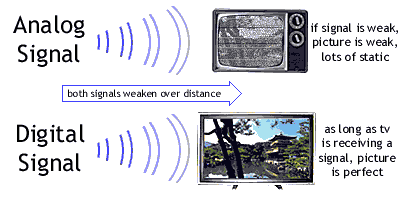What makes digital television so special? A digital image isn't inherently better than an analog image, and in some cases it can be worse. An HDTV picture doesn't have to be digital either; Japanese HDTV is broadcast over an analog signal. There has to be another reason why the United States is choosing to go through the pain of switching from analog to digital.

In fact, there are several good reasons to go digital, including: how much data it can transmit, how consistent the data stays over distance, and what type of data the signal can carry. For the same amount of bandwidth, you can stuff a lot more information into a digital signal than an analog signal. A digital signal doesn't produce the same problems with the picture we see on a distant analog television, either. And television in the digital age won't be limited to video and audio; our televisions will become truly interactive. Combined with HDTV and digital sound, this means a better picture, better sound, and digital data. But how are we going to fit all this into the same amount of frequency?
 |
|

Unlike many other countries, the United States is converting to both digital signals and high-definition pictures at the same time. Some countries are already broadcasting high-definition pictures, but they're using an analog signal. To send more picture detail, they just expanded the amount of frequency bandwidth for each. Broadcasters in the United States won't have the option to expand the size of their signal. They'll have to squeeze more picture detail into the same bandwidth they were using for analog television.

An advantage digital has over analog is that analog signals can't be compressed as well as a digital signal can. To transmit an image on analog television, every pixel is included in the signal. A standard NTSC screen includes 525 lines of 720 pixels, for a total of 378,000 pixels per frame. That's a lot, but it fits into the 6MHz bandwidth of a television channel. Japanese HDTV takes 20 MHz of bandwidth to send pictures with over 675,000 pixels. That's over two times as much signal to send a high definition picture and higher quality sound, but no other data.
In the United States, a standard ATSC (Advanced Television Systems Committee) screen can have up to 1080 lines of 1920 pixels each, or 2,073,600 pixels per frame. Somehow, more than five times as much information will need to squeeze into the same bandwidth of 6Mhz. That doesn't include the compressed audio or data. So how are they going to do that? The same way the compression software on your computer squeezes your files. Well, almost the same way.Remember the days before cable television when someone in the family would assume the job of antenna contortionist? To improve that ephemeral picture to a viewable standard, they would skillfully adjust the alignment, length, and altitude of the antenna to get the best possible picture. But sometimes the picture would still show a foggy double image or ghostly images from the next channel. All these problems are caused by the weak signals from distant or blocked transmitters.
A basic natural law that our technology can't overcome is the weakening of television signals as they travel away from the transmitter and around or through objects. Both analog and digital signals get weaker with distance. However, while the picture on an analog TV slowly gets worse for more distant receivers, a picture on a digital set will stay perfect until the signal becomes too weak for the receiver to pick it up. By perfect I mean the picture on the TV is exactly the same picture the broadcaster started with at the transmitter. In a digital signal, a one is always a one and a zero is always a zero. |




No comments:
Post a Comment